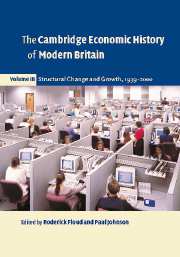Book contents
- Frontmatter
- Chapter 1 The war-time economy, 1939–1945
- Chapter 2 Failure followed by success or success followed by failure? A re-examination of British economic growth since 1949
- Chapter 3 The performance of manufacturing
- Chapter 4 A failed experiment: the state ownership of industry
- Chapter 5 Employment, education and human capital
- Chapter 6 Money and monetary policy since 1945
- Chapter 7 The financial services sector since 1945
- Chapter 8 Economic policy
- Chapter 9 The welfare state, income and living standards
- Chapter 10 The rise of the service economy
- Chapter 11 Impact of Europe
- Chapter 12 Technology in post-war Britain
- Chapter 13 Regional development and policy
- Chapter 14 British fiscal policy since 1939
- Chapter 15 Industrial relations and the economy
- References
- Index
Chapter 1 - The war-time economy, 1939–1945
Published online by Cambridge University Press: 28 March 2008
- Frontmatter
- Chapter 1 The war-time economy, 1939–1945
- Chapter 2 Failure followed by success or success followed by failure? A re-examination of British economic growth since 1949
- Chapter 3 The performance of manufacturing
- Chapter 4 A failed experiment: the state ownership of industry
- Chapter 5 Employment, education and human capital
- Chapter 6 Money and monetary policy since 1945
- Chapter 7 The financial services sector since 1945
- Chapter 8 Economic policy
- Chapter 9 The welfare state, income and living standards
- Chapter 10 The rise of the service economy
- Chapter 11 Impact of Europe
- Chapter 12 Technology in post-war Britain
- Chapter 13 Regional development and policy
- Chapter 14 British fiscal policy since 1939
- Chapter 15 Industrial relations and the economy
- References
- Index
Summary
INTRODUCTION
During the Second World War Britain was transformed from a predominantly free-market economy into a centrally managed economy as it moved from a peacetime footing to one of full-scale war mobilisation. The transformation is shown in Table 1.1: expenditure on war-related activities increased from around 7 per cent of net national expenditure in 1938 to 53 per cent by 1941 and peaked at 55 per cent in 1943, at which time it totalled £4,512 million. This increase was achieved through substantial negative non-war capital formation and by severely curtailing the growth in the consumption of non-war goods and services. In 1938 the latter had stood at £4,090 million but, despite the rapid war-time growth of the economy, it had reached only £4,526 million by 1943 and its share of net national expenditure had fallen by 32 percentage points. The greater involvement of the state in the economy is also clearly demonstrated by accounted for more than half of the net national expenditure; this transformation was almost entirely due to its increased expenditure on war.
This chapter will examine several issues related to the war economy. Why did the role of the state increase? How did the war affect GDP, productivity and the broad industrial structure of the economy? How did Britain perform relative to other combatant nations? What were the constraints that the war-time economy operated under and how did it deal with them? Did the war have any long term impact on the British economy?
- Type
- Chapter
- Information
- The Cambridge Economic History of Modern Britain , pp. 1 - 26Publisher: Cambridge University PressPrint publication year: 2004
- 4
- Cited by



